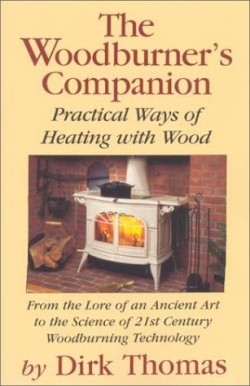The Woodburner's Companion
Practical Ways of Heating With Wood
Already, news reports are quoting woodstove dealers as seeing a surge of new consumers due to skyrocketing prices of home heating oil and natural gas. This book arrives just in time to help these new users of an ancient heat source learn how to use it safely. Long-time wood-burners will likely find some good tips as well.
Thomas, a professional chimney sweep who has written articles for The Chicago Tribune, Country Journal, Vermont Magazine, and American Woodlands, has heated with wood himself for thirty-five years. As a chimney sweep, he’s also seen plenty of poorly installed stoves and chimneys and ill-informed wood burning practices that can lead to creosote build-up and other fire hazards.
His experience doesn’t end there. He’s also been a logger, tree surgeon, and commercial firewood cutter. He provides tips not only on safe ways to heat with wood in stoves, fireplaces, and furnaces, but on the comparative heating potential of different kinds of wood, how to tell if you’re truly getting seasoned wood, and even how to stack it so it stays at just the right moisture content to burn clean and warm.
In 1992, Thomas wrote the Harrowsmith Country Life Guide to Wood Heat, and this latest book includes that material as well. He includes, for example, information about new kinds of woodstoves that dramatically reduce pollution over those built prior to Environmental Protection Agency regulations. They also burn wood more efficiently, so less wood is needed to heat a home.
“Wood heating equipment has improved drastically since the 1970s,” he writes. “Wood may not be the fuel of the future, but it is certainly a fuel of the future for millions of people weary of high-priced fossil fuels, power outages and power shortages.”
It is also a cozy, radiant heat that many people—Thomas included — enjoy. Thomas, however, is clear-headed in his assessment of who should heat with wood and who should not. Those who shouldn’t range from people who live in populated valleys where the wood smoke is trapped as pollution in cold air that can’t rise above the valleys’ steep walls to the neat-nik who can’t stand a bit of ash, dust, and wood chips in the house. “True neat freaks will find themselves dreading the heating season if they have a wood stove,” he writes.
Thomas gives tips on how to reduce the mess, along with pros and cons of different kinds of woodburners and clear instructions on different techniques to burn wood safely, efficiently, and comfortably. He also offers advice on planning for a woodburner installation in an about-to-be-built new home as well as in an older home. Thomas provides some revealing incidents that show why the homeowner is the one who should get educated on wood heating. His book is a valuable tool for doing just that.
Reviewed by
Diane Conners
Disclosure: This article is not an endorsement, but a review. The publisher of this book provided free copies of the book to have their book reviewed by a professional reviewer. No fee was paid by the publisher for this review. Foreword Reviews only recommends books that we love. Foreword Magazine, Inc. is disclosing this in accordance with the Federal Trade Commission’s 16 CFR, Part 255.

